Debugging Complex Authentication Workflows in Syncloop

Challenges in Debugging Authentication Workflows
- Multi-Step Complexity: Issues can occur at any stage, from input validation to token issuance.
- Integration with Third-Party Systems: Failures in external identity providers can disrupt authentication workflows.
- Conditional Logic: Errors in branching conditions can lead to incorrect or incomplete authentication paths.
- Security Constraints: Debugging must maintain strict compliance with security policies to avoid exposing sensitive data.
Syncloop’s debugging tools address these challenges by providing visibility, control, and error recovery capabilities.
Key Features of Syncloop for Debugging Authentication Workflows
1. Workflow Visualization
Visualize the entire authentication process, including data flow, decision points, and integrations.
2. Detailed Logging
Access logs for each step of the authentication workflow, capturing inputs, outputs, and errors.
3. Real-Time Monitoring
Track authentication metrics such as success rates, latency, and failure patterns.
4. Conditional Debugging
Test specific branches of the workflow to identify errors in conditional logic or rules.
5. Error Recovery Mechanisms
Implement retry controls and fallback workflows to handle transient authentication failures gracefully.
6. Secure Debugging
Ensure all debugging activities comply with security standards, protecting sensitive credentials and tokens.
Steps to Debug Authentication Workflows with Syncloop
Step 1: Analyze Workflow Design
- Use Syncloop’s visual workflow designer to review:
- Steps involved in the authentication process.
- Conditional logic used for decision-making.
- External system integrations (e.g., identity providers, MFA services).
- Identify potential bottlenecks or misconfigured steps.
Step 2: Review Logs for Errors
- Access detailed logs for failed authentication attempts to trace issues such as:
- Invalid inputs (e.g., incorrect credentials or tokens).
- Errors from external identity providers.
- Misconfigured roles or permissions.
- Look for patterns or recurring errors to pinpoint systemic issues.
Step 3: Test Conditional Logic
- Use Syncloop’s Ifelse debugging tools to simulate various authentication scenarios, such as:
- Successful and failed login attempts.
- Role-based access conditions.
- Multi-factor authentication flows.
- Verify that the workflow behaves as expected for all branches and conditions.
Step 4: Validate External Integrations
- Test connections to third-party systems, such as:
- OAuth or SAML identity providers.
- MFA services or SMS gateways.
- Ensure that API keys, tokens, and endpoint configurations are correct.
Step 5: Monitor Authentication Metrics
- Use Syncloop’s monitoring tools to track metrics like:
- Authentication success and failure rates.
- Latency for each step of the workflow.
- Usage patterns across endpoints and users.
- Identify anomalies or deviations from expected behavior.
Step 6: Implement Error Recovery
- Configure retry mechanisms to handle transient failures, such as network timeouts or temporary service unavailability.
- Use fallback workflows to:
- Redirect users to alternative authentication methods.
- Notify administrators of critical failures.
Real-World Applications
1. Enterprise Applications
- Use Case: Debug complex role-based access workflows for internal systems.
- Features Used: Workflow visualization, conditional debugging, monitoring tools.
2. E-Commerce Platforms
- Use Case: Resolve authentication issues with third-party payment or identity services.
- Features Used: Log analysis, external integration validation, error recovery.
3. Healthcare Systems
- Use Case: Debug workflows for HIPAA-compliant MFA and secure login mechanisms.
- Features Used: Secure debugging, real-time monitoring, detailed logging.
4. IoT Ecosystems
- Use Case: Manage device authentication workflows involving certificates and tokens.
- Features Used: Workflow visualization, conditional debugging, error handling.
Best Practices for Debugging Authentication Workflows
- Document Workflows Clearly: Maintain up-to-date diagrams and documentation for authentication processes.
- Monitor Continuously: Use real-time metrics to detect and address issues proactively.
- Secure Debugging Data: Protect logs and monitoring data to prevent unauthorized access to sensitive information.
- Test Extensively: Simulate various scenarios to ensure all branches and conditions are thoroughly validated.
- Implement Fallback Mechanisms: Plan for failures with alternative workflows and clear user notifications.
Why Choose Syncloop for Authentication Workflows?
Syncloop offers comprehensive tools for designing, monitoring, and debugging complex authentication workflows. Its intuitive interface, robust logging, and secure debugging capabilities make it an ideal platform for managing authentication processes at scale.
Conclusion
Authentication workflows are the backbone of secure systems, and debugging them requires precision and the right tools. Syncloop provides the features needed to visualize, monitor, and troubleshoot these workflows efficiently, ensuring seamless and secure authentication experiences. By leveraging Syncloop, developers can build resilient authentication systems that meet the demands of modern applications.
Back to Blogs